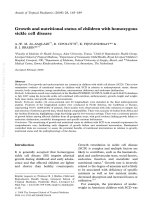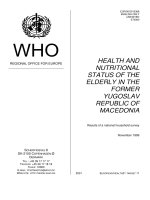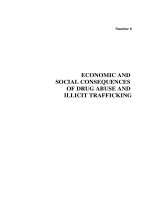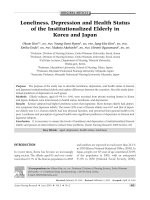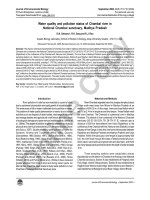Socio- personal, economic and psychological status of buffalo owners in Murrah breeding tract of Haryana
Bạn đang xem bản rút gọn của tài liệu. Xem và tải ngay bản đầy đủ của tài liệu tại đây (294.19 KB, 9 trang )
Int.J.Curr.Microbiol.App.Sci (2019) 8(8): 2446-2454
International Journal of Current Microbiology and Applied Sciences
ISSN: 2319-7706 Volume 8 Number 08 (2019)
Journal homepage:
Original Research Article
/>
Socio- Personal, Economic and Psychological Status of
Buffalo Owners in Murrah Breeding Tract of Haryana
Rekha Yadav1*, Hema Tripathi2, Parveen Kumar3 and Nukala Ramesh4
1
Department of Animal Husbandry & Dairying, Government of Haryana, India
2
TOTE, ICAR-CIRB Hisar
3
Division of Veterinary Microbiology, LUVAS, Hisar
4
Division of Extension Education, ICAR-IVRI, Izatnagar, Bareilly (U.P.), India
*Corresponding author
ABSTRACT
Keywords
Buffalo owners,
Socio- personal,
Economic and
psychological
status, Murrah
breeding tract
Article Info
Accepted:
22 July 2019
Available Online:
10 August 2019
Present study was conducted with objective to explore the socio- personal,
economic and psychological characteristics and information seeking behaviour of
buffalo owners in Hisar and Jind district i.e. part of Murrah breeding tract of
Haryana. Data was collected by interviewing 240 buffalo owners personally.
Study revealed that majority of respondents were found in age group of 37-57
years, came from nuclear and small size family, medium family education status,
small herd size, high risk orientation and medium economic motivation. Majority
had less than 2 ha of land, agriculture as main occupation and belonged to low
annual gross income category by earning ≤ Rs. 400000 per annum. They were
utilizing informal sources for getting information related to animal husbandry at
low level, medium level of formal and mass media sources.
Introduction
India’s livestock sector is one of the largest in
the world with a holding of 11.6 per cent of
world livestock population (512.06 million)
comprising of buffaloes (57.83%) (Livestock
census, 2012). Contribution of agriculture in
GDP of country is 17.4 per cent (India
Economic survey, 2015-16), in which animal
husbandry and dairy constitute 33 per cent.
India is the largest producer of milk i.e. 165.4
million tonnes (NDDB, 2017), with 49 per
cent share of buffalo (DAHDF, 2016-17).
Livestock population has been decreased by
3.33 per cent while, the population of buffalo
has increased by 3.19 per cent (Livestock
census, 2012). Livestock contributed 16% to
the income of small farm households as
against an average of 14% for all rural
households (Livestock census, 2012).
Livestock provides livelihood to two-third of
the rural community. It also provides
2446
Int.J.Curr.Microbiol.App.Sci (2019) 8(8): 2446-2454
employment to about 8.8% of the population
in India. For further improve the contribution
of this sector in livelihood security there is
need that farmers should have access to
technology, training, resources and veterinary
extension services rendered by public sector
or private. So, there is indispensable need of
the service providers to know about the socioeconomic status of the livestock farmers to
provide aforesaid services need based and
efficiently. Keeping in view, the present study
was designed with the objective of studying
the
socio-personal,
economic
and
psychological profile of the buffalo owners.
Materials and Methods
The present study was carried out following
ex-post facto and exploratory research design
in Murrah breeding tract of Haryana
comprising seven districts. Amongst these, 2
districts; Hisar and Jind were selected
purposively for the study because of
familiarity of the researcher with the local
language, customs and culture that helped in
building up rapport with the respondents.
From each of the selected districts, 120
buffalo owners were selected randomly, thus
240 respondents were selected and data were
collected by personal interview and
observation and results were expressed in
frequency and per cent.
of respondents were in middle age group (3757 years), followed by young (32.9%) and
20.8 per cent fell under 57-76 years of age
group. The mean age was 44 years. Earlier
studies conducted by Pavan et al., (2016) in
Karnatka and Sabapara et al., (2016) in
southern Gujarat on dairy animal keepers also
find that more number of respondents fell
under middle age category.
Caste
Table further shows that overall majority of
respondents (75.8%) belonged to General
category, followed by Schedule caste (12.9%)
and rest 11.3 per cent belonged to other
backward class category. This indicates that
buffalo rearing occupation is not restricted to
any one caste or category in Haryana.
Type of house
Majority of respondents (91.7%) were having
Pucca house followed by mixed (7.1%),
Kuchha (1.3%) and no one was having hut in
studied area. It indicate that buffalo farmers in
Haryana are quite progressive and had Pucca
house for their living.
Family structure
Family structure included family size and
family type.
Results and Discussion
Family type
Socio-personal
owners
profile
of
the
buffalo
This includes the age, caste, type of house,
family type, family size, family education
status, family main occupation, herd size and
herd structure.
Majority (73.7%) of respondents came from
nuclear family system and rest 26.3 per cent
belonged to joint family (Table 4.2). Sarita et
al., (2016) also report that majority (73.3%)
of dairy farmers in Hisar district of Haryana
has nuclear family system.
Age
Family size
Table 1 reveals that nearly forty six percent
Table indicates that majority of respondents
2447
Int.J.Curr.Microbiol.App.Sci (2019) 8(8): 2446-2454
(73.3%) had small size family i.e. up to seven
(7) members followed by respondents
(22.1%) having medium size family
comprising 8-11 members. Only few per cent
of respondents (4.6%) also had large size
family with more than 12 members. Jyoti
(2015) and Pavan et al., (2016) while
studying on dairy farmers in Uttar Pradesh
and Karnataka, find that majority of
respondents have medium size family with 46 members. However, Devaki et al., (2015),
Balaraju (2016) and Rekha et al., (2017)
report that majority of dairy farmers in
Tamilnadu, Karnataka and Haryana state have
small family size.
Family education status
Table 1 points out that majority of
respondents (61.7%) fell under medium
followed by high (34.2%) and low (4.2%)
family education status categories with mean
schooling of 4.83 ± 1.29 years. Results are in
consonance with Balaraju (2016) who also
find that more number of respondents (43%)
belonged to medium family education status.
However Rekha et al., (2017) reveal that
majority of women dairy farmers (57.78%) in
Rewari district of Haryana belonged to low
family education status. The differences may
be due to the gender as in present study cent
per cent respondents were male.
Family land holding
The mean size of land holding was 1.88 ha
per family. More number of respondents
(29.6%) belonged to large farmers category
followed by small (28.7%) and marginal
(27.1%). Rest 14.6 per cent respondents were
landless. Rachna et al., (2017) while studying
on dairy farmers reveals that family land
holding varies between 1 to 6 acres in
Haryana. The results of study indicate that
buffalo owning farmers of Haryana had large
size of land holding as majority owned more
than one hectare of land and this is quite high
as national average land holding size is 0.12
ha (World bank, 2015).
Family occupation
Agriculture was found to be main occupation
revealed by majority of respondents (60.0%)
followed by animal husbandry (16.2%),
government service (11.2%), self-employed
(5.8%) and equal per cent of respondents
were engaged in private service and labour
(3.3% each). It clearly revealed that
agriculture is still main livelihood source in
studied area. The reason being that more than
half of the country’s population depend on
agriculture for employment and state of
Haryana is no exception to it. Livestock
sector act as a source for supplying additional
family income, milk, meat, manure, fuel and
drought power. The present study are in line
with many studies conducted recently by
Prakash et al., (2014), Adesh et al., (2014),
Rekha (2015) and Balaraju (2016) wherein
majority of respondents have agriculture as
their main occupation in various state of India
including Haryana.
Herd size
Table 1 indicates that majority of sampled
household (71.7%) had small size of livestock
holding comprising of ≤ 5.0 cattle equivalent
score followed by medium (18.8%) and large
livestock holding (9.5%) with respective
cattle equivalents score of 5.1-10.0 and ≥10
animal heads. An average size of livestock
holding was 4.9 as per cattle equivalent score.
Earlier authors Sabapara et al., (2016), Rekha
et al., (2017) also reported small herd size
being maintained by majority of dairy farmers
in southern Gujarat and Haryana respectively.
Herd composition
Perusal of the Table 1 reveals that majority of
2448
Int.J.Curr.Microbiol.App.Sci (2019) 8(8): 2446-2454
respondents (64.2%) were rearing exclusively
buffalo followed by combination of buffalo +
cattle (34.5%) and buffalo + small ruminant
(1.3%). People of Haryana generally rear the
good quality animals for milk because it is
one of the major dietary components of
routine life and studied area also being the
breeding tract of Murrah breed. This may be
one of the reasons that majority were rearing
buffalo only. The distribution was common in
both the selected locales under study.
husbandry practices. Results of the present
study are in line with Mukesh et al., (2015)
who reported more than sixty seven percent of
the respondents in Jharkhand had medium to
high level of exposure to mass media. Devaki
et al., (2015) and Sabapara et al., (2016) also
reported that majority of respondents in
Thiruvallur district of Tamilnadu and
southern Gujarat had medium level of
utilization of mass media sources.
Socio-economic profile of the buffalo
owners
Information seeking behaviour
Information seeking behaviour was measured
by dividing the sources of information in
three categories i.e. formal, informal and mass
media. For each source, data were collected
on three point continuum scale i.e. Always,
Sometime and Never to understand their
extent of use of various sources.
Informal sources
Table 2 reveals that majority of respondents
(58.8%) were seeking less information from
informal sources with score between as 5.007.33. About thirty four per cent respondents
fell under medium level of use and rest only
7.4 per cent were utilizing at high level.
Formal sources
Majority of respondents (67.9%) were
utilizing formal sources of information at
medium level as per the scores achieved by
them, followed by high (20%) and low
categories (12.1%).
Mass media sources
Majority of respondents (82.9%) fell under
medium category revealing that mass media
sources were being utilizing by the
respondents for receiving, sharing and
utilizing the information related to buffalo
This includes the gross family annual income
and income generation through dairy. Gross
family annual income referred as total income
of the family earned through various sources
viz., agriculture, animal husbandry, labour,
business service etc. in a year. Income
generation through dairy was operationalized
as income earned from the milch buffalo
rearing per annum through sale of milk, milk
products, dung and buffaloes and was
calculated by subtracting annual expenditure
on dairying from annual gross income in
dairying during data collection period i.e.
2017.
Gross family annual income
A perusal of the Table 3 reveals that majority
of respondents (67.1%) belonged to low gross
annual income category i.e. Rs. ≤ 400000
followed by 27.1 per cent respondents
belonged to medium category (Rs. 400001 –
810164). Nearly 6 per cent respondents fell
under high annual gross income category.
Earlier studies as conducted by Prakash et al.,
(2014) and Adesh et al., (2014) reported
average annual income of the majority of the
farmers are Rs. 30097 – Rs. 232220 and Rs.
80,000 – 1, 30,000 in Karnataka, Maharashtra
and Uttar Pradesh respectively. Wherein in
our study the average annual income was
about three and half lakh.
2449
Int.J.Curr.Microbiol.App.Sci (2019) 8(8): 2446-2454
Table.1 Distribution of respondents according to their socio-personal characteristics (N=240)
Characteristics
Age (Years)
Young (18-37)
Middle (37-57
Old (57-76)
Mean ± S.D.
Caste
Schedule Caste
Other Backward Caste
General
Type of house
Hut
kuccha
Mixed
Pucca
Family structure (family type and family size)
Family type
Nuclear
Joint
Family size
Small (≤ 7)
Medium (8 - 11)
Large (≥12)
Mean ± S.D.
Family education status (Score)
Low (0-2.67)
Medium (2.67-5.34)
High (5.34-8)
Mean ± S.D.
Family land holding (ha)
Landless
Marginal (<1)
Small (1-2)
Large (>2)
Mean ± S.D.
Family occupation
Agriculture
Animal Husbandry
Government service
Labourer
Private service
Self-employed
Herd size (Cattle Equivalent Score)
Small (≤5.0)
Medium (5.1-10.0)
Large (≥10.0)
Mean ± S.D.
Herd composition
Buffalo only
Buffalo+ Cattle
Buffalo+ Small ruminant
Buffalo+ Cattle + Small ruminant
2450
Frequency
Per cent
79
111
50
44.66 ± 13.39
32.9
46.3
20.8
31
27
182
12.9
11.3
75.8
3
17
220
1.2
7.1
91.7
177
63
73.7
26.3
176
53
11
6.2 ± 2.7
73.3
22.1
4.6
10
148
82
4.83 ± 1.29
4.2
61.6
34.2
35
65
69
71
1.88 ± 2.36
14.6
27.1
28.7
29.6
144
39
27
8
8
14
172
45
23
4.9 ± 4.7
154
83
3
-
60.0
16.2
11.2
3.4
3.4
5.8
71.7
18.8
9.5
64.2
34.5
1.3
-
Int.J.Curr.Microbiol.App.Sci (2019) 8(8): 2446-2454
Table.2 Distribution of respondents according to their information seeking behaviour (N=240)
Characteristics
Frequency
Per cent
Low (5.00- 7.33)
141
58.8
Medium (7.34 - 9.67)
81
33.8
High (9.67-12)
18
7.4
Low (12.00- 13.66)
29
12.1
Medium (13.67 - 15.33)
163
67.9
High (15.34-17.00)
48
20
Low (6.00- 9.33)
36
15
Medium (9.34 - 12.67)
199
82.9
High (12.67-16.00)
5
2.1
Informal sources (Scores)
Formal sources (Scores)
Mass media sources (Scores)
Table.3 Distribution of respondents according to their socio-economic characteristics (N=240)
Characteristics
Frequency
Per cent
Low (≤ 400000)
161
67.1
Medium (400001 – 810164)
65
27.1
High (≥ 810165)
14
5.8
Mean ± S.D.
359682 ± 306530
Gross family annual income (in ₹ )
Income generation from dairying in a year (in ₹ )
Low (≤ 164339)
185
77.1
Medium (164340 - 327170)
42
17.5
High (≥ 327171)
13
5.4
Mean ± S.D.
122544 ± 96251
2451
Int.J.Curr.Microbiol.App.Sci (2019) 8(8): 2446-2454
Table.4 Distribution of respondents according to their socio-psychological characteristics
(N=240)
Characteristics
Risk orientation (Scores)
Low (8-13.33)
Medium (13.33-18.66)
High (18.66-24)
Economic motivation (Scores)
Low (15-18)
Medium (18-21)
High (21-24)
Income generation in a year through milch
buffaloes
A perusal of the Table 3 reveals that majority
of respondents (77.1%) belonged to low
income category i.e. Rs. ≤ 164339 followed
by 17.5 per cent respondents belonged to
medium category (Rs. 164340 - 327170).
About 5 per cent respondents fell under high
income category. Earlier studies as conducted
by Yogendra singh (2013) reported that 63.13
per cent of the beneficiaries of integrated
murrah development scheme belong to
medium average annual income (Rs. 9347 –
55643) and Rekha et al., (2015) reported that
60 per cent respondents under low income
category (Rs. 15000-31683) from dairy in
Haryana state.
Socio-psychological profile of the buffalo
owners
This includes the risk orientation and
economic motivation of the respondents
towards animal husbandry.
Risk orientation
Table 4 reveals that 49.2 per cent of
respondents fell under high risk orientation
category followed by medium (28.7%) and
Frequency
Per cent
53
69
118
22.1
28.7
49.2
22
144
74
9.2
60.0
30.8
low (22.1%). It could be justified in the sense
that more number of respondents came from
small and large farmers categories and they
might be ready to take high risk in adoption of
scientific practices of dairy for high
production.
Economic motivation
Majority of the respondents (60 %) were
inclined for economic gains from buffalo
farming followed by high (30.8%) and low
(9.2%) level. Results of our study are in
consonance with Sarita et al., (2016) who also
find that majority of dairy farmers belonged
to medium economic motivation category in
Haryana. However Ravi (2009) and Mali et
al., (2014) reported high economic motivation
in majority of dairy farmers of Bareilly
district of Uttar Pradesh and Belgaum district
of Karnataka state respectively.
In view of the above findings, it may be
concluded that buffalo farmers of this region
were educated, risk oriented, economically
motivated and had sufficient land for fodder
production. Agriculture was the main
occupation of the majority of the buffalo
owners and income from buffalo rearing is
contributing a significant share in the total
income of the farmers in the studied area.
2452
Int.J.Curr.Microbiol.App.Sci (2019) 8(8): 2446-2454
Acknowledgement
The authors are thankful to Director, ICARIVRI, Izzatnagar and Director, ICAR-CIRB,
Hisar for providing facilities for conduction
of the research work.
References
Annual Report. 2016-17. Department of
Animal Husbandry, Dairying &
Fisheries Ministry of Agriculture &
Farmers Welfare, Government of India.
Retrieved
from
/>nual%20Report%202016-17.pdf
Balaraju, B. L. 2016. Role of Indigenous
cattle in the livelihood security of
resource poor farmers: An exploratory
study in Karnataka. Ph. D. Thesis,
Indian Veterinary Research Institute,
Uttar Pradesh, India.
Belakeri,
P.,
K.
Satyanarayan,
V.
Jagadeeswary, M. Kumar, S. Yathiraj,
K. C. Veeranna and Rajeshwari Y. B.
2016. Socio-economic characteristics
and information seeking behavior of
livestock farmers of Karnataka, India.
International Journal of Science
Environment
and
Technology.
5(6):4320 – 4327.
Devaki,
K.,
Senthilkumar,
K.
and
Subramanian, R. 2015. Socio-Economic
profile of livestock farm women of
Thiruvallur
district,
Tamilnadu.
International Journal of Science
Environment
and
Technology.
4(5):1322 – 1329.
India Economic Survey. 2015-16. Finance
ministry, New Delhi, Manager of
publication. 5 p.
Jadoun, Y. S. 2013. Integrated Murrah
development scheme in Haryana: a
critical appraisal. M.V.Sc. Thesis,
National Dairy Research Institute,
Karnal, Haryana, India.
Kumar, M., Gupta, J., Radhakrishnan, A. and
Singh, M. 2015. Socio-economic Status
and role of livestock to improve
livelihood of tribes of Jharkhand.
Research Journal of Agricultural
Sciences. 6: 1421-1425.
Kumar, R. 2009. An Evaluation of Cattle
Breeding interventions on Livelihood
Security among dairy farmers: A Baif’s
Case. Ph.D. Thesis, Indian Veterinary
Research Institute, Uttar Pradesh, India.
Mali, K. N., Belli, R. B. and Kitturmath, M.
G. 2014. Study of the socio - economic
characteristics of dairy and non- dairy
farmers. Hind agricultural research and
training institute. 9(1):54-58.
Nineteenth
Livestock
Census.
2012.
Department of Animal Husbandry,
Dairying and Fisheries. Ministry of
Agriculture,
Krishi
Bhawan,
Government of India. New Delhi. 16 p.
Rachna, Gautam, Malik, A., Sangwan, S. S.,
Khirbat, R. and Kamaldeep. 2017.
Socio- economic profile of dairy
farmers in Hisar district of Haryana.
The Asian Journal of Animal Science.
12(1): 88-94.
Rathod, P. K., Nikam,T. R., Landge, S.,
Vajreshwari, S. and Hatey, A. 2011.
Participation of rural women in dairy
farming in Karnatka. Indian Research
Journal of Extension Education. 11(2):
31-36.
Report of National dairy Development Board.
2017.
Retrieved
from
/>milkprodindia on 22/07/2017
Sabapara, G. P., Fulsoundar, A. B. and
Kharadi, V. B. 2016. Profile of dairy
farmers and relationship with adoption
of improved dairy husbandry practices
in southern Gujarat India. Livestock
Research International. 4(1):36-40.
Sarita, Singh, S. P., Malik, A., Sharma, M.
and Ahuja, R. 2016. Socio-economic
and psychological characteristics of
2453
Int.J.Curr.Microbiol.App.Sci (2019) 8(8): 2446-2454
dairy farmers of Hisar district.
International Journal of Science,
Environment and Technology. 5(5):
3466 – 3472.
Verma, A. K., Lal, N., Avhad, S. R. and Hari
R. 2014. Socio-economic status of
farmers
rearing
Kherigarh,
an
indigenous breed of cattle. The Asian
Journal of animal science. 9(2): 134–
137.
World
Bank.
2015.
/>le-land-hectares-per-person-wbdata.html
Yadav, J. 2015. Effectiveness of livestock
extension service delivery for women
farmers under state department of
animal husbandry in central plain zone
of Uttar Pradesh. Ph.D. Thesis, Indian
Veterinary Research Institute, Izatnagar,
India.
Yadav, R., Sagar, M. P., Kumar, P.,Yadav, J.,
Singh, D. and Kumar, A. 2017. SocioEconomic Status of Dairy Based
Women Self Help Group Members
under SGSY in Rewari District of
Haryana, India. International Journal of
Current Microbiology and Applied
Science. 6(11): 5385-5390.
How to cite this article:
Rekha Yadav, Hema Tripathi, Parveen Kumar and Nukala Ramesh. 2019. Socio- Personal,
Economic and Psychological Status of Buffalo Owners in Murrah Breeding Tract of Haryana.
Int.J.Curr.Microbiol.App.Sci. 8(08): 2446-2454. doi: />
2454


